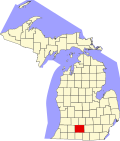Wagner's Block | |
 | |
| Location | 143 W. Michigan Ave., Marshall, Michigan |
|---|---|
| Coordinates | 42°16′19″N84°57′38″W / 42.27194°N 84.96056°W |
| Area | less than one acre |
| Built | 1870 |
| Architect | John Mills Van Osdel |
| Architectural style | Second Empire |
| Part of | Marshall Michigan Historic Landmark District (ID91002053) |
| NRHP reference No. | 71000385 [1] |
| Added to NRHP | October 7, 1971 |
Wagner's Block is a historic commercial building located at 143 West Michigan Avenue in Marshall, Michigan. It was listed on the National Register of Historic Places in 1971. [1]
